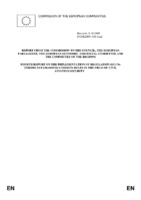| dc.description.abstract | 2008 marked a significant stage in the building of an effective aviation security regime in the European Community. It was the year of lessons learned, a time for fundamental reassessment, drawing on 5 years' experience of implementing and inspecting the regime adopted in 2002 after the 9/11 terrorist attacks. It was also a year of enhanced international co-operation and further technological development. The reassessment process revealed much that was positive. The main requirements of the legislation were clearly understood and generally well implemented at European airports. Levels of compliance continued to move – albeit slowly – upwards and several Member States had increased their compliance monitoring resources. However, it was also evident that some provisions did require adjustment, to achieve a common understanding, address recurring deficiencies or take account of other developments. The inspection regimes themselves were equally in need of fine-tuning. The Community response to new and emerging threats was similarly challenged, following the considerable disruption caused by the 2006 liquid explosives alert. This led to increased efforts to collaborate with manufacturers and international partners in the development of security screening procedures. It added impetus to the drive towards reaching agreement with third countries on recognition processes. Throughout, the EU demonstrated its willingness and ability to make an effective contribution towards facilitating passenger movements and finding global solutions. Finally, and fundamental to the whole process, was a recognition of the need for greater transparency. The restrictions on access to much of the implementing legislation had come to be judged as excessive, with members of the public not able to retrieve the facts necessary for making informed decisions. In response, there was an immediate restructuring of the original provisions and a commitment to ensure appropriate levels of access in the future. In all, 2008 was a year of considerable achievement towards the establishment of a mature aviation security environment. Member States, the aviation industry and manufacturers demonstrated a high level of commitment in working together to find security solutions and minimise inconvenience to passengers. However, at the end of the twelve month period, none would remain in any doubt about the considerable amount of work still to be done. |

